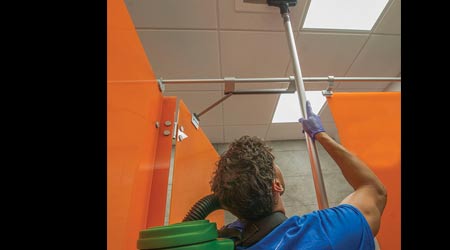In the facilities contracted with Ace, the main duties are vacuuming, cleaning restrooms and taking out the trash every Monday through Thursday. High dusting is typically performed at the end of the week. Then all the surfaces at medium height such as cubicles and walls are dusted, and finally the low surfaces are cleaned.
“You always want to dust from high to low and our dusting duties are typically done on Friday or during weekend visits to buildings,” says Shor. “This ensures we are always dusting in the right order.”
What high surfaces are included in this dusting regime? Shor says ceiling tiles, ceilings, walls, vents, light fixtures, skylights, blinds and window shades all qualify.
“At first, we had one of our supervisors vacuum high surfaces every six months, but that wasn’t often enough,” says Shor. “We now offer high dusting as a service every quarter unless the customer wants to sign up for every six weeks,” says Shor. “Grocery stores like us to high dust more frequently and normally opt for the six-week frequency.”
To sell potential clients on hiring Ace, Shor says he offers dusting in high areas at no additional cost. He says that has increased his selling position.
Offering his high dusting program also helps his own employees, says Shor.
“If we don’t do it, they have to work harder because the dust accumulates faster,” he says.
If a janitorial company isn’t extracting the dust in those hard-to-reach high locations with a vacuum, they’re only redistributing it throughout the building.
Shor did his research and decided on Mosquito backpack vacuums for his cleaning company. When it came to the high-dust extraction tools, he went with two different brands — ProTeam and Cen-Tec — because they’re both universal and fit on his vacuums. Shor purchases high-dusting kits which usually consist of three telescopic extension wands: one is straight, one has a 45-degree curved end, and the third has a 130-degree curved end. With these attachments, his employees can reach as high as 21 feet without using dangerous ladders or scissor lifts.
He cautions others in the industry that from a technical standpoint, the longer the distance between the attachment and the vacuum, the less efficient the dust and dirt removal will be.
“The wand attachments we use typically have brush heads on them,” says Shor. “This allows for some agitation of the dust on the surface, so it can be extracted into the vacuum through the attached wand.”
What should BSCs look for in an attachment? They want enough suction to seize the dust, not just knock it off a surface. They also want a good, locking fit between the attachment and the vacuum so nobody gets hit with a flying wand. The wand should also be lightweight yet have enough rigidity for controlled handling. Depending on what surfaces are found in the places it cleans, a BSC will probably need both curved and straight attachments.
Source: https://bit.ly/37p4zM4





Recent Comments